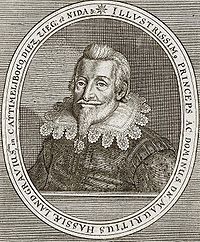Loading AI tools
Landgrave of Hesse-Kassel From Wikipedia, the free encyclopedia
Maurice of Hesse-Kassel (German: Moritz; 25 May 1572 – 15 March 1632), also called Maurice the Learned[1] or Moritz, was the Landgrave of Hesse-Kassel (or Hesse-Cassel) in the Holy Roman Empire from 1592 to 1627.
This article needs additional citations for verification. (November 2010) |
| Maurice | |
|---|---|
 Portrait of Maurice of Hesse-Kassel from the work Theatrum Europaeum (1662). | |
| Landgrave of Hesse-Kassel | |
| Reign | 25 August 1592 – 17 March 1627 |
| Predecessor | William IV |
| Successor | William V |
| Born | 25 May 1572 Kassel, Hesse-Kassel |
| Died | 15 March 1632 (aged 59) Eschwege, Hesse-Kassel |
| Spouse | |
| Issue Detail | Otto, Hereditary Prince of Hesse-Kassel Elisabeth, Duchess of Mecklenburg William V, Landgrave of Hesse-Kassel Agnes, Princess of Anhalt-Dessau Herman IV, Landgrave of Hesse-Rotenburg Magdalene, Countess of Salm-Reifferscheid Sophie, Countess of Schaumburg-Lippe Frederick, Landgrave of Hesse-Eschwege Ernest, Landgrave of Hesse-Rheinfels |
| House | Hesse-Kassel |
| Father | William IV, Landgrave of Hesse-Kassel |
| Mother | Sabine of Württemberg |
Maurice was born in Kassel as the son of William IV, Landgrave of Hesse-Kassel, and of his wife Sabine of Württemberg.
Although Maurice had been raised in the Lutheran faith, he converted to Calvinism in 1605. On the principle Cuius regio eius religio, Maurice's subjects were also required to convert to Calvinism. Maurice's conversion was controversial since the Peace of Augsburg had only settled religious matters betweens Roman Catholics and Lutherans and had not considered Calvinists. Maurice tried to introduce Calvinism to the lands which he had inherited from the extinct Hesse-Marburg branch of his family. Such a change of faith was contrary to the inheritance rules, and resulted in an ongoing conflict with the Hesse-Darmstadt branch. It also brought him into conflict with the Holy Roman Emperor, Matthias.
English strolling players ('Die Englische Comoedianten') were frequent visitors to, and performers in, towns and cities in Germany and other European countries, including Kassel, during the 16th and 17th centuries. Landgraf Moritz (to use his German nomenclature) was a great supporter of the performing arts and even built the first permanent theatre in Germany, named the Ottoneum, in 1605. This building still exists today but as a Natural History Museum.
In 1609, Maurice played a leading role in mediating the Treaty of Dortmund, which aimed to determine the succession of Julich-Cleves-Berg. He did so with support from King Henry IV of France.[2]
Maurice's actions (though not necessarily the Ottoneum) ruined Hesse-Kassel financially. In 1627 he abdicated in favour of his son William V.[1] Five years later he died in Eschwege. He was not only a serious musician but an expert composer (a Pavane of his, for the lute, has several times been recorded by both lutenists and guitarists). The leading musical figures whom he supported included Heinrich Schütz and John Dowland.
On 23 September 1593, Maurice married Agnes of Solms-Laubach (7 January 1578 – 23 November 1602). They had six children:
On 22 May 1603, Maurice married Countess Juliane of Nassau-Siegen (3 September 1587 – 15 February 1643). They had fourteen children:
| Ancestors of Maurice, Landgrave of Hesse-Kassel | |||||||||||||||||||||||||||||||||||||||||||||||||||||||||||||||||||||||||||||||||||||||||||||||||||||||||||||||||||||||||||||||||||||||||||||||||||||||||||||||||||||||||||||||||||||||||||||||||||||||||||||||||||||||||||||||||||||||||||||||||||||||||||||||||||||||||||||||||||||||||
|---|---|---|---|---|---|---|---|---|---|---|---|---|---|---|---|---|---|---|---|---|---|---|---|---|---|---|---|---|---|---|---|---|---|---|---|---|---|---|---|---|---|---|---|---|---|---|---|---|---|---|---|---|---|---|---|---|---|---|---|---|---|---|---|---|---|---|---|---|---|---|---|---|---|---|---|---|---|---|---|---|---|---|---|---|---|---|---|---|---|---|---|---|---|---|---|---|---|---|---|---|---|---|---|---|---|---|---|---|---|---|---|---|---|---|---|---|---|---|---|---|---|---|---|---|---|---|---|---|---|---|---|---|---|---|---|---|---|---|---|---|---|---|---|---|---|---|---|---|---|---|---|---|---|---|---|---|---|---|---|---|---|---|---|---|---|---|---|---|---|---|---|---|---|---|---|---|---|---|---|---|---|---|---|---|---|---|---|---|---|---|---|---|---|---|---|---|---|---|---|---|---|---|---|---|---|---|---|---|---|---|---|---|---|---|---|---|---|---|---|---|---|---|---|---|---|---|---|---|---|---|---|---|---|---|---|---|---|---|---|---|---|---|---|---|---|---|---|---|---|---|---|---|---|---|---|---|---|---|---|---|---|---|---|---|---|---|---|---|---|---|---|---|---|---|---|---|---|---|---|---|---|
| |||||||||||||||||||||||||||||||||||||||||||||||||||||||||||||||||||||||||||||||||||||||||||||||||||||||||||||||||||||||||||||||||||||||||||||||||||||||||||||||||||||||||||||||||||||||||||||||||||||||||||||||||||||||||||||||||||||||||||||||||||||||||||||||||||||||||||||||||||||||||
Seamless Wikipedia browsing. On steroids.
Every time you click a link to Wikipedia, Wiktionary or Wikiquote in your browser's search results, it will show the modern Wikiwand interface.
Wikiwand extension is a five stars, simple, with minimum permission required to keep your browsing private, safe and transparent.